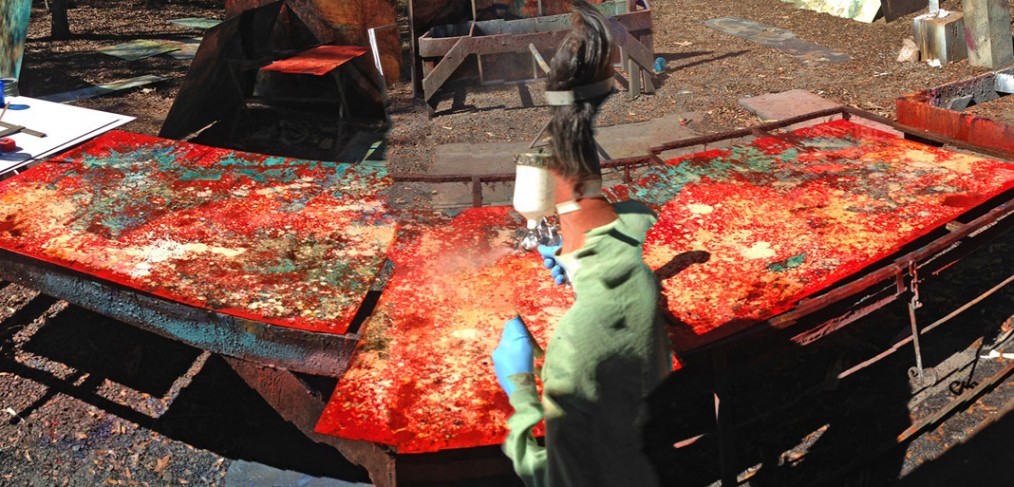
A late blooming artist, Paul Tamanian likes ‘edgy stuff’
By Randi Atwood – TALLAHASSEE DEMOCRAT | October 2011
Popular Tallahassee artist Paul Tamanian has no formal art training. In fact, he never even had an interest in art until he was almost 40, when he took a pottery class at Lafayette Park with his girlfriend. “I was terrible.” he laughs. “I couldn’t even center a glob of clay on the wheel. I didn’t even know what composition was. But I kept plodding away. I did crazy thing. I nickel-plated clay when they told me I couldn’t. People told me ‘don’t quit your day job.'”
At the time Tamanian was the manager of Bill’s Art City, but he says that had nothing to do with him becoming an artist. “At the time, my art was more therapeutic than anything else.” he says. “I had clay all over my kitchen and I was experimenting with different techniques, just constantly trying to break the rules. It was ironic, really, because I was managing an art supply store and I never used art supplies.”
Eventually he did finally decide to concentrate on becoming a full-time artist. “I packed 25 years of training into the next 12 or 13 years. I didn’t take a vacation or a week off that whole time. I was learning the hard way,” says Tamanian. “If I had taken the normal path with a wife and a car and a mortgage, I wouldn’t have been able to do this.”
Now Tamanian’s artwork can be seen in galleries all over the country and is practically ubiquitous in Tallahassee.
“I do sell a lot of work here,” he says, “Datamaxx was my first big private sell, and FSU bought some of my work for the medical school. Florida Commerce has bought a lot of work, and Holland and Knight, and lots of the local law firms. “It happens all different ways,” say Tamanian. “People can select from work I already have, or I will do commissions. FSU had a whole committee that came to my house to look, and they actually bought a piece right out of my living room.”
One way his sales don’t happen is over the internet. Unlike many artists these days, Tamanian refuses to embrace electronic media. “My work reads so horribly online that having a website is almost a detriment rather than a help to me,” he says. “If I got a call from a gallery in New York and they wanted to see examples of my work, I’d grab three paintings and get on a plane. I would not want them looking at my work online. I’ve never failed at a sale if I can get the actual work in front of the buyer.” He believes in putting his money, effort and energy directly into his artwork, and thinks that many artists get so caught up in things like Facebook that they become distracted from their purpose. “Part of my rant, my whole thing has been to keep the main thing the main thing,” he says. “I did have a web page that someone made for me for, like, four years, and I never got a single phone call from it.”
Tamanian describes his artwork as “organic contemporary abstract painting,” He works primarily in enamel paint on pre-primed aluminum – raw materials that are extremely expensive. “I spend between $3,000 and $8,000 a month in materials alone,” says Tamanian. “Sometimes I use $800 worth of metal for one painting. And people don’t realize that it can take dozens of experimental works to end up with one little area that I’m happy with.”
Even after years as a professional artist, Tamanian is still always trying new things. He believes in what he calls the “what if?”factor, and is always willing to risk ruining a piece in order to try a new technique. “I like edgier stuff,” he says. “I might have to do 50 paintings to learn how to make a new method work. But artists are supposed to be creative, right? What would creative about painting the same sunset over and over?” In fact, Tamanian never paints sunsets or portraits at all. He believes that good – really good – abstract work is the hardest thing artists can do. He also enjoys the spontaneity of starting a piece and not knowing how it’s going to turn out.
“I love doing big work. I did some paintings for FSU that were 14 feet long,” he says. “That’s the nice part of working with aluminum – there’s no real size limit. While I’m young – well, maybe not young, but while I physically can do it – I want to keep working big.” The trick, says Tamanian, is to create these large pieces while keeping his prices low enough to be affordable. “I’m trying to flex my prices with the economy, so that I can keep working,” he says. “If I kept raising my prices, I would only sell one painting a year. I really like the fact that you don’t have to be a millionaire to but one of my paintings.”
Tamanian will be one of the featured artists at 621 Gallery’s 17th Annual Art Auction this week and has been one of their biggest art donors for several years. “I just think it’s kind of the right thing to do,” says Tamanian. “As an artist, I like to see a gallery like 621, where younger people or outsider artists can get seen, and where I can go see interesting work. I’m constantly being asked to donate to auctions, and I try not to turn down too much. I donate as much as I can while still trying to get the best prices out where they’ll sell and fund more work.”
